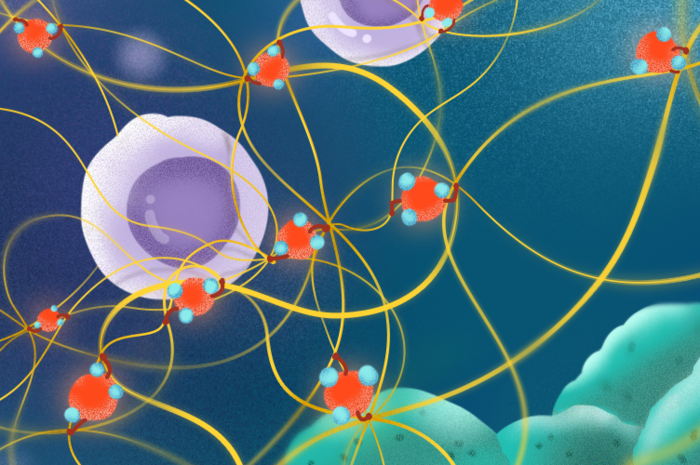According to research published in eLife, scientists have discovered a mechanism that explains how small air pollution particles may cause lung cancer.
 Inhaled fine particulate matter (shown here in red) pulls strings of collagen to disturb the immune defense in mice with lung cancer cells. This activity delays the movement of cytotoxic T-cells (purple) as they migrate towards the cancer cells (green) to destroy them. Image Credit: Wang et al. (CC BY 4.0).
Inhaled fine particulate matter (shown here in red) pulls strings of collagen to disturb the immune defense in mice with lung cancer cells. This activity delays the movement of cytotoxic T-cells (purple) as they migrate towards the cancer cells (green) to destroy them. Image Credit: Wang et al. (CC BY 4.0).
The discoveries might lead to new techniques for avoiding or treating the disease’s early lung changes.
Fine particulate matter (FPM), a tiny, inhalable particle present in air pollution, has been identified as a Group 1 carcinogen and a significant hazard to world health. FPM’s cancer-causing mechanism, on the other hand, is unknown.
Despite its potential to cause mutations, recent research suggests that FPM does not directly promote—and may even inhibit—the growth of lung cancer cells. This suggests that FPM might lead to cancer through indirect means that support tumor growth. For example, some studies suggest FPM can prevent immune cells from moving to where they are needed.”
Zhenzhen Wang, Study First Author and Associate Researcher, Nanjing University
Zhenzhen Wang conducted the research in collaboration with NJU and the University of Macau, where Wang was supported by a University of Macau Fellowship.
To investigate this possibility, Wang and his colleagues gathered FPM from seven different areas in China and evaluated its effects on cytotoxic T-cells (CTLs), which are the key immune cells that fight tumor development. CTLs were driven to the lungs of mice given lung cancer cells but not exposed to FPM to eliminate the tumor cells. CTL infiltration was delayed in mice whose lungs were subjected to FPM, potentially allowing tumor cells to establish themselves in lung tissue.
The scientists looked at both the CTLs and the lung tissue structure to figure out why the CTLs did not reach the lungs as rapidly in the FPM-exposed lungs. CTLs exposed to FPM preserved their migratory capabilities, but FPM treatment significantly constricted the lung tissue structure and the gaps between which immune cells migrate.
Collagen, a protein that gives biomechanical support for cells and tissues, was also substantially greater. When the researchers looked at the mobility of CTLs in mice, they found that those in FPM-treated lung tissue struggled to move, but those in untreated tissue moved readily.
Increases in a collagen subtype termed collagen IV were shown to be the source of structural changes in the tissue, but the research was still unsure how FPM triggered this. When researchers looked more at the structural changes in collagen IV and the enzyme that causes them, termed peroxidasin, they discovered the answer. This enzyme causes and aggravates a specific type of cross-linking in lung tissue that has been linked to FPM exposure.
Wang adds, “The most surprising find was the mechanism by which this process occurred. The peroxidasin enzyme stuck to the FPM in the lung, which increased its activity. Taken together, this means that wherever FPM lands in the lung, increased peroxidasin activity leads to structural changes in the lung tissue that can keep immune cells out and away from growing tumor cells.”
Our study reveals a completely new mechanism by which inhaled fine particles promote lung tumor development. We provide direct evidence that proteins that stick to fine particulate matter can cause a significant and adverse effect, giving rise to pathogenic activity. Our discovery that peroxidasin is the mediator of this effect in lung tissue identifies it as a specific and unexpected target for preventing lung disease caused by air pollution.”
Lei Dong, Study Senior Author and Professor, School of Life Sciences, Nanjing University
Source:
Journal reference:
Wang, Z., et al. (2022) Air pollution particles hijack peroxidasin to disrupt immunosurveillance and promote lung cancer. eLife. doi.org/10.7554/eLife.75345.